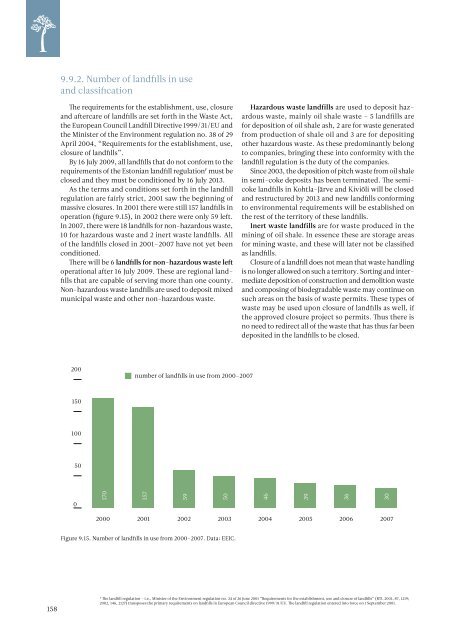ESTONIAN ENVIRONMENTAL REVIEW 2009
ESTONIAN ENVIRONMENTAL REVIEW 2009
ESTONIAN ENVIRONMENTAL REVIEW 2009
Create successful ePaper yourself
Turn your PDF publications into a flip-book with our unique Google optimized e-Paper software.
9.9.2. Number of landfills in use<br />
and classification<br />
The requirements for the establishment, use, closure<br />
and aftercare of landfills are set forth in the Waste Act,<br />
the European Council Landfill Directive 1999/31/EU and<br />
the Minister of the Environment regulation no. 38 of 29<br />
April 2004, “Requirements for the establishment, use,<br />
closure of landfills”.<br />
By 16 July <strong>2009</strong>, all landfills that do not conform to the<br />
requirements of the Estonian landfill regulation F must be<br />
closed and they must be conditioned by 16 July 2013.<br />
As the terms and conditions set forth in the landfill<br />
regulation are fairly strict, 2001 saw the beginning of<br />
massive closures. In 2001 there were still 157 landfills in<br />
operation (figure 9.15), in 2002 there were only 59 left.<br />
In 2007, there were 18 landfills for non-hazardous waste,<br />
10 for hazardous waste and 2 inert waste landfills. All<br />
of the landfills closed in 2001–2007 have not yet been<br />
conditioned.<br />
There will be 6 landfills for non-hazardous waste left<br />
operational after 16 July <strong>2009</strong>. These are regional landfills<br />
that are capable of serving more than one county.<br />
Non-hazardous waste landfills are used to deposit mixed<br />
municipal waste and other non-hazardous waste.<br />
Hazardous waste landfills are used to deposit hazardous<br />
waste, mainly oil shale waste – 5 landfills are<br />
for deposition of oil shale ash, 2 are for waste generated<br />
from production of shale oil and 3 are for depositing<br />
other hazardous waste. As these predominantly belong<br />
to companies, bringing these into conformity with the<br />
landfill regulation is the duty of the companies.<br />
Since 2003, the deposition of pitch waste from oil shale<br />
in semi-coke deposits has been terminated. The semicoke<br />
landfills in Kohtla-Järve and Kiviõli will be closed<br />
and restructured by 2013 and new landfills conforming<br />
to environmental requirements will be established on<br />
the rest of the territory of these landfills.<br />
Inert waste landfills are for waste produced in the<br />
mining of oil shale. In essence these are storage areas<br />
for mining waste, and these will later not be classified<br />
as landfills.<br />
Closure of a landfill does not mean that waste handling<br />
is no longer allowed on such a territory. Sorting and intermediate<br />
deposition of construction and demolition waste<br />
and composing of biodegradable waste may continue on<br />
such areas on the basis of waste permits. These types of<br />
waste may be used upon closure of landfills as well, if<br />
the approved closure project so permits. Thus there is<br />
no need to redirect all of the waste that has thus far been<br />
deposited in the landfills to be closed.<br />
200<br />
number of landfills in use from 2000–2007<br />
150<br />
100<br />
P<br />
50<br />
0<br />
170<br />
157<br />
59<br />
50<br />
46<br />
39<br />
36<br />
30<br />
2000 2001 2002 2003 2004 2005 2006 2007<br />
Figure 9.15. Number of landfills in use from 2000–2007. Data: EEIC.<br />
158<br />
F<br />
The landfill regulation – i.e., Minister of the Environment regulation no. 34 of 26 June 2001 “Requirements for the establishment, use and closure of landfills” (RTL 2001, 87, 1219;<br />
2002, 146, 2127) transposes the primary requirements on landfills in European Council directive 1999/31/EU. The landfill regulation entered into force on 1 September 2001.

















